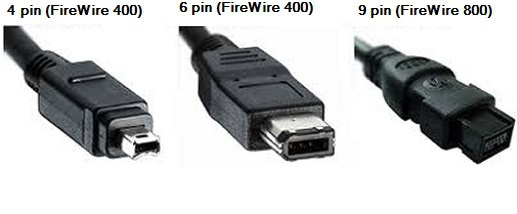There are various PC connection interfaces . In this category USB has the largest share of the market due to its ease of use and device compatibility
PCIe stands for PCI Express card bus and it is an internal bus.
IEEE 1394,USB,eSATA are used for external hard disk connections
Most commonly used Video connectors include VGA, HDMI, and DVI.
For connecting an LCD monitor, you need a digital signal connector such as DVI or HDMI. PGA, and VGA are analog standards.
The different versions of USB cables, like USB 2.0 and USB 3.0, are concerned with the functionality and speed of the USB cable; whereas, the type of USB cable (like USB Type A, USB Type B) essentially refers to the physical design of the plugs and ports.
USB is used for connecting USB-compliant peripheral devices, and eSATA is used for connecting external eSATA devices such as eSATA disk drives.
There are a variety of USB connectors as illustrated in the figure below:

Most prominent among these are Type A, Type B, Mini Type A, Mini Type B, Type Micro A, and Type micro B.
Firewire Cable Connector:The IEEE 1394 interface is a serial bus interface standard for high-speed communications, frequently used by personal computers as well as in digital audio and digital video. The interface is also known by the brand names of FireWire (Apple), i.LINK (Sony), and Lynx (Texas Instruments).
There are two prominent versions of this standard.
IEEE1394a
IEEE1394b
IEEE 1394a, also called FireWire 400 is widely used for formats such as DV, DVCAM, DVCPRO, and HDV. FireWire provides an easy way to capture and output high-quality digital video using a variety of camcorders and decks and is capable of data rates as high as 400 Mbps. Standard FireWire cables can be up to 4.5 meters long. 16 cables can be daisy chained using active repeaters offering a total cable length of 72meters. There are two kinds of FireWire connectors: a 4-pin connector (typically found on video equipment such as camcorders or decks) and a 6-pin connector (used for computer equipment). However, some newer video equipment uses the 6-pin connector. The 6-conductor powered connector, adds power output to support external devices.
IEEE 1394b, also called FireWire 800, offers higher-bandwidths capable of data transfer speeds of up to 800 Mbit/s. In fact, the FireWire roadmap outlined in the IEEE 1394b standard will eventually take the theoretical bit rate to 1600 Mbps and then up to a staggering 3200 Mbps. FireWire 800 is also capable of supporting cable distances of up to 100 meters. 9-pin-to-4-pin and 9-pin-to-6-pin FireWire 400 to FireWire 800 cables are available to connect older devices to a FireWire 800 interface.
Different types of FireWire cable connectors are shown below:

Display connectors:

VGA : A Video Graphics Array (VGA) connector is a three-row 15-pin DE-15 connector. The 15-pin VGA connector was provided on many video cards, computer monitors, laptop computers, projectors, and high definition television sets. On laptop computers or other small devices, a mini-VGA port was sometimes used in place of the full-sized VGA connector.
HDMI (High-Definition Multimedia Interface) is a proprietary audio/video interface for transmitting uncompressed video data and compressed or uncompressed digital audio data from an Compliant source device, such as a display controller, to a compatible computer monitor, video projector, digital television, or digital audio device. HDMI is a digital replacement for analog video standards.
BNC Connector : The BNC connector is a miniature quick connect/disconnect radio frequency connector used for coaxial cable. BNC connectors are used with coaxial cable in radio, television, and other radio-frequency electronic equipment, test instruments, and video signals. The BNC was commonly used for early computer networks such as ARCnet, and the 10BASE2 variant of Ethernet. BNC connectors are made to match the characteristic impedance of cable at either 50 ohms or 75 ohms.
Display Port :DisplayPort is a digital display interface developed by the Video Electronics Standards Association (VESA). The interface is primarily used to connect a video source to a display device such as a computer monitor, though it can also be used to carry audio, USB, and other forms of data.
Display Port is backwards compatible with VGA, DVI and HDMI through the use of passive and active adapters.
Digital Visual Interface (DVI) is a video display interface developed by the Digital Display Working Group (DDWG). The interface is designed to transmit uncompressed digital video and can be configured to support multiple modes such as DVI-A (analog only), DVI-D (digital only) or DVI-I (digital and analog). The DVI specification is compatible with the VGA interface. Although DVI is predominantly associated with computers, it is sometimes used in other consumer electronics such as television sets and DVD
6-Pin Mini Din Connector : The mini-DIN connectors are a family of multi-pin electrical connectors used in a variety of applications. Mini-DIN is similar to the larger, older DIN connector. Mini-DIN connectors are 9.5 mm in diameter and come in seven patterns, with the number of pins from three to nine. Each pattern is keyed in such a way that a plug with one pattern cannot be mated with any socket of another pattern.
The raw speeds (bits per sec) achievable by using different technologies is given below:
The following are usually hot pluggable devices:
1. ESATA (even SATA is hot pluggable under XP and Vista)
2. USB
3. Express card/54
But you need to follow proper procedures if you want to remove a USB or eSATA device while the computer is on. The Personal Computer Memory Card International Association (PCMCIA) developed the both the Express Card standard and the PC card standards. The host device supports both PCI Express and USB 2.0 connectivity through the Express Card slot, cards can be designed to use either mode. The cards are hot-pluggable
For connecting to an Ethernet LAN, you need an RJ-45 connector at the network end of the cable. The maximum allowed length of the cable for 1000BaseT Gigabit Ethernet is 100 meters (without repeater). Cat 5e or better cable type is used for Gigabit Ethernet network cabling. Cat5e cable contains four twisted pairs of wires for Gigabit Ethernet
Note that RJ-11 connector has only two pairs of wires, and normally used for connecting telephones.
USB is used for connecting USB-compliant peripheral devices, and eSATA is used for connecting external eSATA devices such as eSATA disk drives.
NFC: NFC, short for Near Field Communication, is a short-range high frequency wireless communication technology that enables the exchange of data between devices over about a 10 cm distance. It allows users to seamlessly share content between digital devices, pay bills wirelessly or even use their cellphone as an electronic traveling ticket on existing contactless infrastructure already in use for public transportation. The significant advantage of NFC over Bluetooth is the shorter set-up time. Instead of performing manual configurations to identify Bluetooth devices, the connection between two NFC devices is established at once (under a 1/10 second).
Due to its shorter range (less than 20cm), NFC provides a higher degree of security than Bluetooth (range of about 50m) and makes NFC suitable for crowded areas where correlating a signal with its transmitting physical device.
There are two different types of NFC:active and passive. Active NFC, which is currently used on many Android devices, as well as the new Apple devices, can send and receive data. Passive NFC, on the other hand, can only send data. However, passive NFC provides an extra benefit: The passive devices can run without power. For example, a student ID card may use NFC technology. If you tap the card on the bus, your card is passively transferring information through NFC to the bus system's active card reader.
IR:Infrared transmissions use the invisible light spectrum to transmit low power signals to compatible devices. There are many applications that can utilize the technology, most notably remote control signaling for control of home theater devices, garage door openers and any dedicated device that has an unobstructed line-of-sight between the devices. Some smart phones incorporate this technology to let users control their multi-media components. It is one of the earliest types of optical communication and found in remote controls for televisions, DVD players and most other entertainment devices and uses Line Of Sight communication.
Note that Infra Red (IR) is one of the earliest types of optical communication and is still very much in use today. It is found in remote controls for televisions, dvd players and most other entertainment devices. It uses Line Of Sight communication and limited to a few meters.
Radio frequency (RF)is any of the electromagnetic wave frequencies that lie in the range extending from around 3 kHz to 300 GHz, which include those frequencies used for communications or radar signals. It is not a relevant option here.

